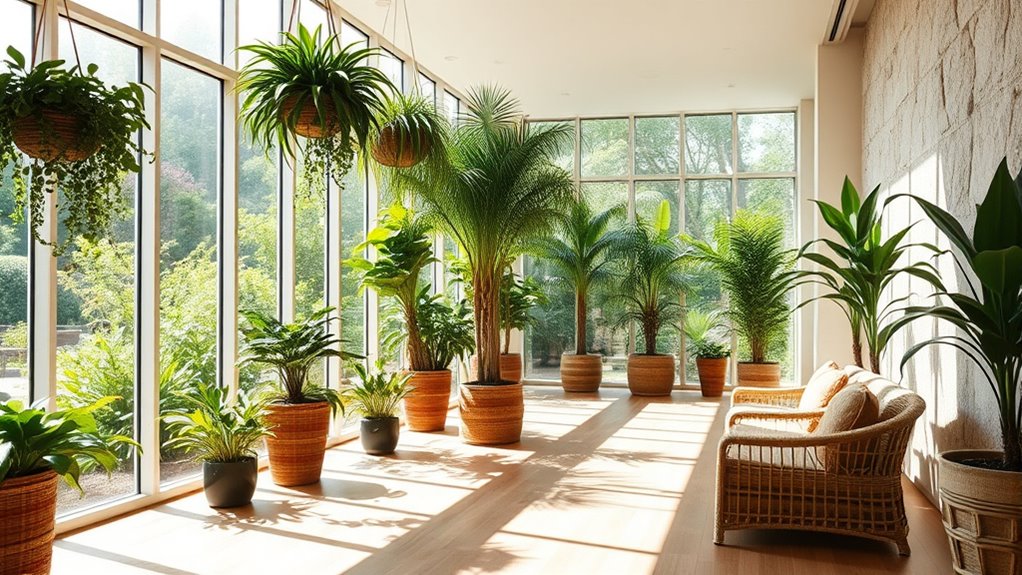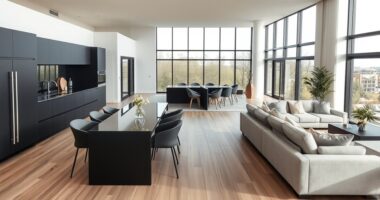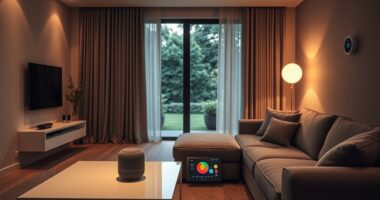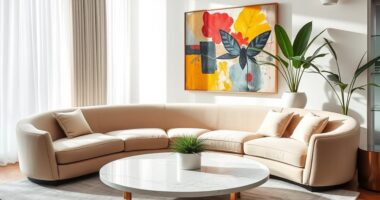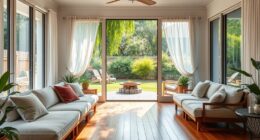Biophilic design involves bringing natural elements like lush plants and plenty of sunlight into your indoor spaces to boost your health and well-being. Incorporate greenery such as ferns or succulents and maximize natural light with large windows or skylights. This approach reduces stress, improves mood, and enhances focus. By intentionally blending nature into your environment, you create a calming and energizing space that supports your physical and mental health—discover the transformative benefits as you explore more.
Key Takeaways
- Integrating indoor plants and natural elements creates calming environments that reduce stress and boost mood.
- Utilizing natural lighting through windows and skylights enhances circadian rhythms and overall well-being.
- Combining greenery with ample sunlight supports mental clarity, physical health, and emotional resilience.
- Practical tips include starting small with plants and optimizing layouts for maximum light exposure.
- Overall, biophilic design transforms indoor spaces into restorative havens promoting health and productivity.
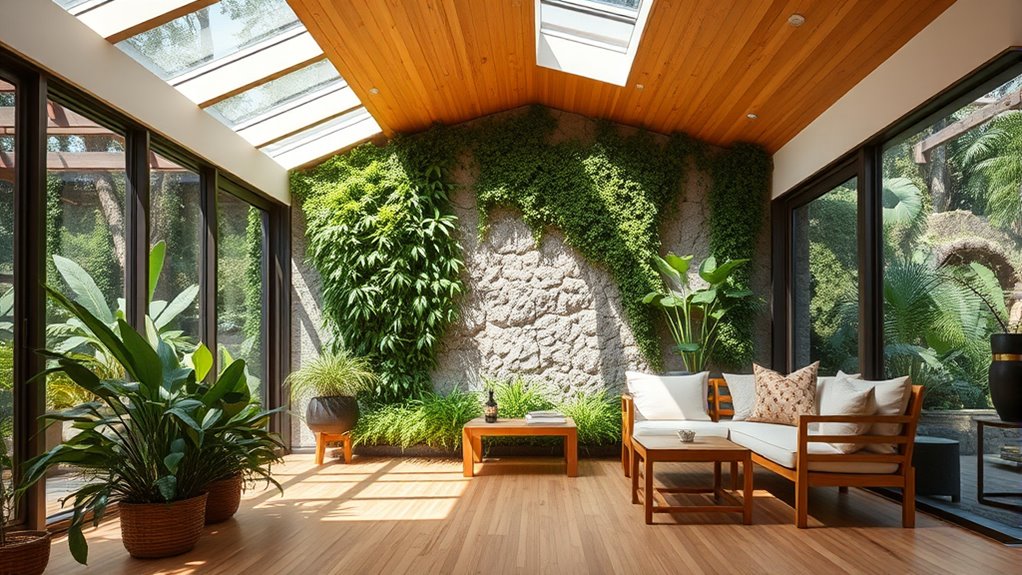
Have you ever wondered how bringing natural elements into built environments can boost your well-being? One of the key principles of biophilic design is integrating indoor greenery to create a calming, invigorating atmosphere. When you add plants to your space, whether they’re lush ferns, vibrant succulents, or trailing vines, you introduce a connection to nature that can reduce stress and increase feelings of tranquility. Indoor greenery not only purifies the air but also enhances your mood and productivity. It’s like having a touch of the outdoors inside your home or office, helping you feel more grounded and energized throughout your day. indoor greenery can also serve as a natural sound absorber, reducing noise levels and creating a more peaceful environment.
Natural lighting plays a vital role in this design approach, too. When your environment maximizes exposure to sunlight, it positively impacts your circadian rhythms, improving your sleep patterns and boosting your overall health. Large windows, skylights, and thoughtfully placed glass doors allow sunlight to flood your space, creating a warm, inviting ambiance. Natural lighting also enhances the visual appeal of indoor greenery, making plants look more vibrant and lifelike. It’s a simple yet powerful way to make your environment feel more open and alive, fostering a sense of harmony and well-being.
Combining indoor greenery with ample natural lighting can transform any space into a sanctuary that promotes mental clarity and physical health. When you’re surrounded by plants and sunlight, you’re more likely to take breaks, breathe deeply, and feel connected to nature—even if you’re inside. This connection has been shown to lower cortisol levels, reduce anxiety, and improve your overall mood. It’s not just about aesthetics; it’s about creating a space that supports your health and emotional resilience.
Incorporating these elements into your environment doesn’t require a complete overhaul. Start small by adding a few houseplants and positioning your desk near a window. Use sheer curtains to diffuse harsh sunlight and prevent glare, while still allowing plenty of natural light to brighten your space. Over time, you might expand your indoor greenery collection or optimize your layout to maximize sunlight exposure. The goal is to craft an environment that feels alive, peaceful, and restorative, making it easier for you to focus, relax, and thrive. With intentional design choices that emphasize indoor greenery and natural lighting, you can turn your space into a nurturing haven rooted in nature’s calming influence.
Frequently Asked Questions
How Does Biophilic Design Improve Mental Health?
You experience improved mental health through biophilic design because it enhances your nature connection, which helps you feel calmer and more grounded. This connection reduces stress levels, making it easier to focus and relax. By integrating natural elements like plants, sunlight, and water features into your environment, you create a soothing space that promotes well-being and mental clarity, ultimately supporting your overall mental health.
What Are Cost-Effective Ways to Incorporate Nature Into Urban Spaces?
Imagine stepping into a city park of the future—cost-effective greenery and urban plantings transform your space without breaking the bank. You can add vertical gardens, rooftop gardens, and street trees to boost greenery efficiently. Use native plants, which require less maintenance, and involve community members in planting events. These simple strategies make nature accessible, affordable, and sustainable, helping you create healthier urban environments that everyone can enjoy.
Can Biophilic Design Enhance Productivity in the Workplace?
Yes, biophilic design can boost your productivity at work. When you add natural lighting, it reduces eye strain and keeps you alert. Using ergonomic furniture promotes comfort and minimizes fatigue, helping you focus better. Incorporating elements like plants or nature-inspired decor creates a calming environment. These features work together to enhance your well-being, making you more efficient and motivated throughout your workday.
How Does Biophilic Design Affect Energy Efficiency in Buildings?
You’ll find biophilic design dramatically boosts energy efficiency, like turning your building into a solar-powered oasis. By integrating natural elements, you enhance thermal regulation, reducing the need for excessive heating or cooling. This leads to significant energy savings, cutting costs and environmental impact. When you bring nature indoors, you create a space that naturally adjusts to temperature changes, making your building smarter, greener, and more efficient—truly a game-changer in energy management.
Are There Any Potential Drawbacks or Limitations of Biophilic Design?
You might face maintenance challenges with biophilic design, as natural elements like plants require regular upkeep. Additionally, allergen concerns can arise if plants or natural materials trigger allergies or respiratory issues. While incorporating nature boosts well-being, you should weigh these limitations, ensuring proper maintenance and selecting allergen-free plants to minimize health risks. Being aware of these potential drawbacks helps you create a balanced, sustainable environment.
Conclusion
By embracing biophilic design, you can profoundly boost your well-being—studies show that employees working in green environments report a 15% increase in productivity. Incorporating natural elements like sunlight, plants, and views of nature into your space isn’t just aesthetically pleasing; it actively improves mental health and reduces stress. So, next time you’re designing or updating a space, remember: connecting with nature isn’t a luxury, it’s an essential step toward enhanced health and happiness.
